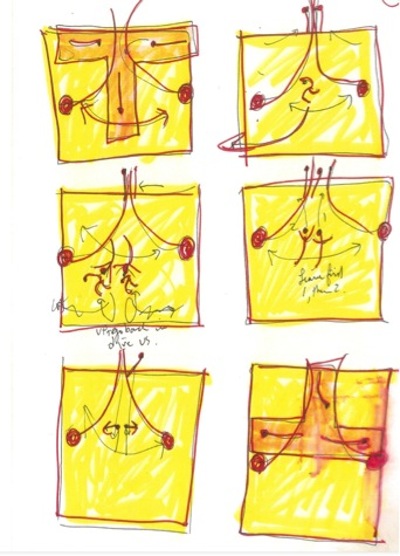[8] Falling & Loving

In other words, the personal “art coefficient” is like an
arithmetical relation between
the unexpressed but intended and the
unintentionally expressed.
—Marcel Duchamp2
1
The old custodian came into the gymnasium as I was trying to figure out what all the contraptions were for, and I asked him if he knew. “I just sweep in here whenever some event is going to happen,” he said. “What do you suppose these are for?” I asked again, pointing to the cords hanging down from the platform overhead. “The cords are fastened,” he said, pointing up to the dozen or more little hoppers, “to those buckets up there and when they pull on the cords all sorts of material is going to fall.” “Like what?” I asked. “Like confetti,” he said, instinctively moving out of the way, “and peanuts, maple syrup, molasses, flour, milk, honey, sugar, popcorn, and mylar, they say.” Two (or maybe there were three) bowling balls were hung on cables or ropes. He pushed one of them, like a tether ball, and it swung back and forth pendulum style. “I heard,” he said, solemnly, “that the dancers have to dive and race through that little space at the perigee where the arcs of these swinging orbs threaten to intersect.” “Timing would be everything,” I added.
when an osprey drops
feet first from the sky, like a bomb
talons sharply out
the impact’s ostentatious
rising phoenix with its prey3
danger as an art
requires us to savor fear
though dodging outcomes
at the very last minute
anyone can hit the wall
it is the moving
around confirms the human
kinesis as life
animals swim, fly, and run
even the trees hold on tight
2
Choreographers use many tools to create and record dances. The moves and gestures, arising out of the body’s spontaneity or the brain’s analysis, drift away like smoke as soon as they occur, unless some means is used to “record” them. One dancer creates moves as she goes, in thin air, and all we can do is rush to write or draw pictures of what we saw or record the motions in the codes of various dance notation systems.4 Another dancer cogitates, imagines, and creates steps and motions, literally out of thin air, and writes them out for live dancers later to perform. The mystery of choreography resides, however, in questions about just how and why the dancer for the first time ever raised her right arm just so, then bent and twisted her torso in that way, or kicked high with her right leg...and just kept on going, pushing the dance in the imagination ahead of her while the dance already danced trailed behind in fading images, like the dragon at Chinese New Year.
drawings do provide
hints approximating dreams
choreographers
have about flying dancers
but they leave out the motion
you can only hint
with the use of curving lines
what you want to say
she flies on his outstretched arms
while escaping gravity
does his arm move first
or the image in his head
does he know just when
to start and stop or does he
wait to see it on paper?
3
Step back, now, and forget ideas of purpose or utility and consider the pictures above as pictures in their own right, as a work of art. Or, rather, see it as a composite work of art—drawings or a painting, on the one hand, made up of six abstract panels AND, at the same time, pushing past the idea of an inexplicit pattern of line, shape, and color, see it as a representation of an imagined dance. The dance abstracted, the abstraction dancing. What do you see when you peer deeply into a red and yellow window by Matisse, beyond the suggestion of some person, say, or the sea? You can’t help but see the underlying geometry, the space and shapes, colors and arrangement. So, here, beyond the idea of dance motion, interaction, and time, is a yellow space, red lines, and stick figures, embodying the artist’s multi-valenced urgency at the time.
say the hardest thing—
art is indeterminate
count off the factors
intention, form, genre, line
and color, just don’t step back
too far, then things bleed
the edge into the center
a sympathetic
eye becomes a crude dollop
smudged with the edge of a thumb
imagination
finishes everything up
following the urge
from blurring gradually out
to the sharp “smack!” on the floor
Bio: Charles D. Tarlton
MacArthur “Genius” Award-winner Elizabeth Streb has dived through glass, allowed a ton of dirt to fall on her head, walked down (the outside of) London’s City Hall, and set herself on fire, among other feats of extreme action. Her popular book, STREB: How to Become an Extreme Action Hero, was made into a hit documentary, Born to Fly,
directed by Catherine Gund (Aubin Pictures). Streb founded Streb Extreme Action in 1979. In 2003, she established SLAM, the STREB Lab for Action Mechanics, in Williamsburg, Brooklyn. SLAM’s garage doors are always open: anyone and everyone can come in, watch rehearsals, take classes, and learn to fly.
